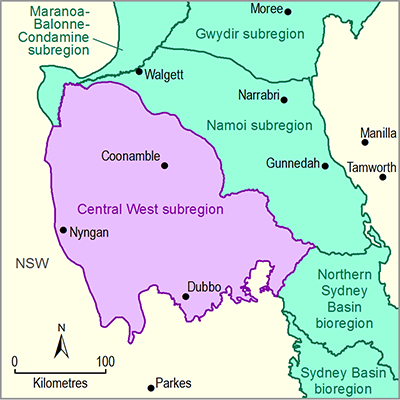- Home
- Assessments
- Bioregional Assessment Program
- Central West subregion
- 1.1 Context statement for the Central West subregion
- 1.1.7 Ecology
- 1.1.7.2 Terrestrial species and communities
1.1.7.2.1 Threatened ecological communities
It has been estimated that only 38% of the subregion’s natural vegetation remains. Of the 82 vegetation types identified, 14 have less than 1000 ha of their pre-European extent remaining and 20 have less than 30% remaining. Thirty-one communities have between 30 and 70% of their pre-European extent remaining and ten have more than 70% remaining (Central West CMA, 2011a). Loss and degradation of habitat remain key threatening processes in the subregion, and restoring habitat and improving the extent and connectivity in the landscape are key state and regional targets (Central West CMA, 2011b). The largest remaining blocks of native vegetation are in national parks, state forests or travelling stock routes. The Goonoo Community Conservation Area within the subregion is the second largest forest remnant remaining in inland NSW (Central West CMA, 2012). Twenty-one broad vegetation groups are not represented in reserves, and only 12 have more than 15% of their extent in conservation areas (Central West CMA, 2011a). Six threatened ecological communities listed under the Commonwealth’s Environment Protection and Biodiversity Conservation Act 1999 (EPBC Act) occur within the Macquarie, Castlereagh and Bogan river basins (Table 18). Endangered communities in the upper catchment include the Tableland Basalt Forest (listed under NSW’s Threatened Species Conservation Act 1995 (TSC Act) in the Sydney Basin and South Eastern Highlands IBRA regions, and the grassy woodland community White Box-Yellow Box-Blakely’s Red Gum Grassy Woodland (listed under the EPBC Act). The Coolibah - Black Box Woodlands of the Darling Riverine Plains and the Brigalow Belt South IBRA bioregions is an endangered community (listed under the EPBC Act) that occurs on the floodplains of the lower Macquarie and Bogan rivers, and is threatened by fragmentation, overgrazing, weed invasion and alteration of flood regimes.
Eleven threatened ecological communities are listed by the NSW Office of Environment and Heritage. Of these the Mount Canobolas Xanthoparmelia Lichen Community is endemic to the Orange region (Table 19), which is upstream of the Central West subregion.
In addition to the communities listed in Table 18 and Table 19, several estates of national significance occur within the Macquarie, Castlereagh and Bogan river basins. These include the Greater Blue Mountains area (listed World Heritage Property, National Heritage Property) and the Warrumbungle National Park and Jenolan Caves (listed National Heritage Properties).
Table 18 Threatened ecological communities in the Macquarie, Castlereagh and Bogan river basins listed under the Commonwealth’s Environment Protection and Biodiversity Conservation Act 1999 (EPBC Act)
Table 19 Threatened ecological communities in the Macquarie, Castlereagh and Bogan river basins listed under the NSW’s Threatened Species Conservation Act 1995 (TSC Act)
1.1.7.2.2 Threatened species
There are 49 aquatic and terrestrial species and 16 migratory species (all birds) listed under the EPBC Act as predicted or known to occur within the Macquarie, Castlereagh and Bogan river basins. The aquatic and terrestrial species include 26 plant, four reptile, one amphibian, six bird and eight mammal species. Listed animal species predicted or known to occur in the river basins are shown in Table 20.
A total of 139 threatened species listed under the TSC Act occur or did occur within the Macquarie, Castlereagh and Bogan river basins. A breakdown of numbers of species within major life-form groups is shown Table 21. An extensive study conducted in the Macquarie, Castlereagh and Bogan river basins assessed the status of all vertebrate species occurring in the subregion and classed them as secure, declining, regionally vulnerable or regionally extinct. From a total of 424,698 fauna records consisting of 551 native vertebrate species and 32 introduced species, 194 (35.2%) were assessed as regionally secure and 313 (56.8%) as regionally vulnerable and regionally endangered. Overall, 65% of species recorded were classed as declining, with reptiles and mammals being the most over represented in the regionally at risk category (Central West CMA, 2008a).
Habitat loss represents the major threat to biodiversity in the Central West subregion; however, other threats include introduced plant and animal species, soil erosion, and inappropriate land uses such as lakebed cropping, exploitation of natural resources and climate change (Central West CMA, 2008a).
Table 20 Threatened animal species predicted or known to occur in the Macquarie, Castlereagh and Bogan river basins listed under the Commonwealth’s Environment Protection and Biodiversity Conservation Act 1999 (EPBC Act)
Source data: Presence information from NSW Office of Environment and Heritage (2013)
Table 21 Number of threatened species in the Macquarie, Castlereagh and Bogan river basins listed under the NSW’s Threatened Species Conservation Act 1995
Source data: NSW Government (2010e)

